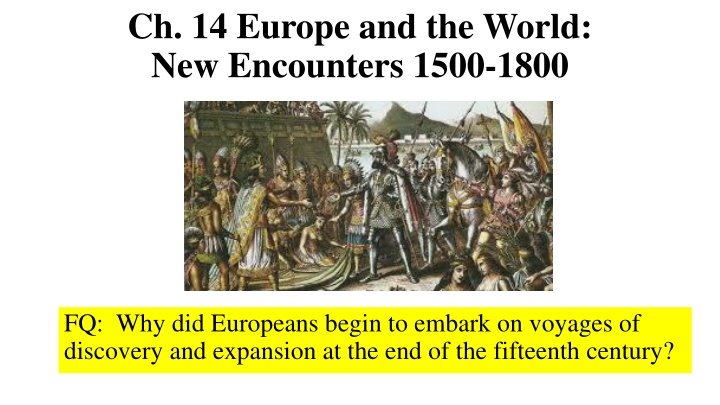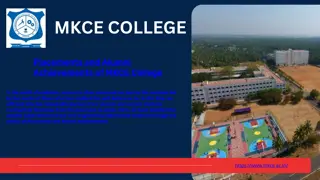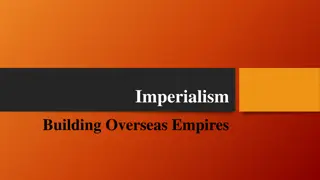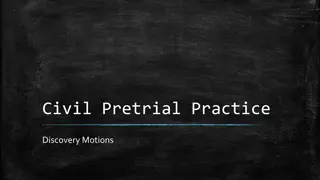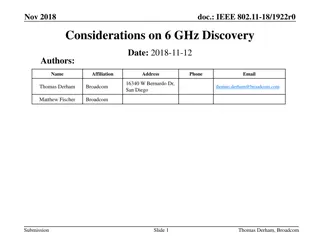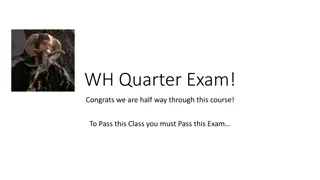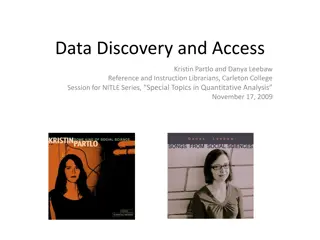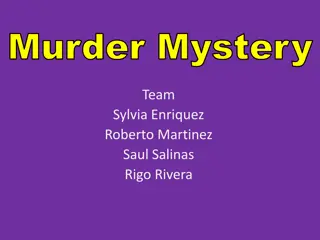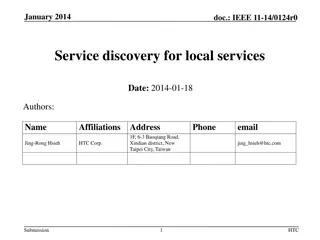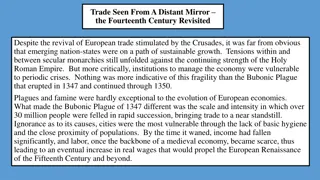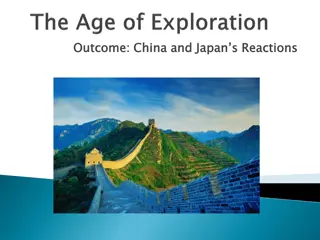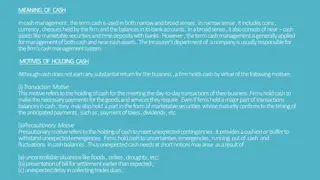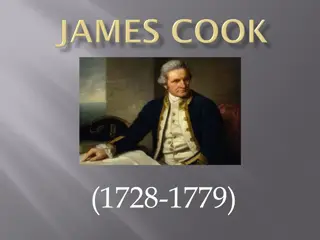European Voyages of Discovery: Motives and Achievements (80 characters)
Europeans embarked on voyages seeking God, glory, and gold at the end of the 15th century. Portugal and Spain acquired overseas empires through exploration, trade, and religious zeal, leading to the discovery of new lands and the establishment of global trade routes. Key figures like Prince Henry the Navigator, Vasco da Gama, and Columbus played significant roles in these historical voyages, shaping the course of world history. (324 characters)
Download Presentation

Please find below an Image/Link to download the presentation.
The content on the website is provided AS IS for your information and personal use only. It may not be sold, licensed, or shared on other websites without obtaining consent from the author.If you encounter any issues during the download, it is possible that the publisher has removed the file from their server.
You are allowed to download the files provided on this website for personal or commercial use, subject to the condition that they are used lawfully. All files are the property of their respective owners.
The content on the website is provided AS IS for your information and personal use only. It may not be sold, licensed, or shared on other websites without obtaining consent from the author.
E N D
Presentation Transcript
Ch. 14 Europe and the World: New Encounters 1500-1800 FQ: Why did Europeans begin to embark on voyages of discovery and expansion at the end of the fifteenth century?
God, glory and gold! Religious zeal: desire to convert the heathen to Christianity Fantastic lands: literature in the Middle Ages glorified adventure and risk. Economic motives: -closing of overland trade routes by the Ottomans led to the search for new areas of trade -gold and silver mining
Maps Navigation was based off of Ptolemy s map found in his 2ndcentury work, the Geography Arab geographers had it in the 8thcentury. Latin translation of the map wasn t found in Europe until the 15th century.
Ships & Sailing New navigational techniques -axial rudder (from China) Mobile enough to sail against the wind and conduct warfare. Used the Pole Star to measure their latitude. Below the equator this was useless. Knowledge of wind patterns
Portugal and Spain FQ: How did Portugal and Spain acquire their overseas empires, and how did their empires differ?
Portuguese Started with the coast of Africa under Prince Henry the Navigator (1394-1460) with the following motives: -find a Christian kingdom to ally against Muslims -trade opportunities -spread Christianity Gold, ivory and slaves were shipped back to Lisbon.
Portuguese in India Vasco De Gama was the first to round the Cape of Africa Admiral Alfonso Albuquerque (1462-1515) established port facilities at Goa and seized the city of Malacca, massacring the Arab population. Portuguese took control of the spice trade from the Muslim traders with the help of superior fire power and seamanship.
The Voyages of Columbus Columbus (1451-1506) -Italian rejected by Portugal -Persuaded Queen Isabella of Spain into financing the expedition Reached the Bahamas, Cuba and island of Hispanola along with parts of central America. America named after Amerigo Vespucci (Florentine explorer)
The Spanish Empire in the New World European disease Superior weapons (steel sword)/fire power Rivalries among native peoples
Seven Myths of the Spanish Conquest by Matthew Restall 1. A handful of Adventurers The myth of exceptional men
Early Civilizations in Mesoamerica Around 300 C.E., the Yucatan peninsula was occupied by the Mayan civilization. -sophisticated calendar, temples and pyramids -most of Central America and southern Mexico -collapsed for unknown reasons around 900 C.E.
Aztec Empire Capital city of Tenochtitlan established between 1325 and 1345. Advanced aqueduct systems helped develop growth of over 80,000 people from the Pacific to the Atlantic. Collection of semi-independent territories governed by local lords.
Spanish Conquest of the Aztec Empire Between 1519 and 1522, Hernan Cortez landed in Veracruz (Gulf of Mexico) and formed alliances with city-states that were tired of oppressive rule of the Aztecs. Aztec monarch, Moctezuma (Montezuma) believed Cortez was a God and offered the foreigners gold along with his palace. Spanish were forced out after the first year. However, Aztecs were devastated by European disease, leading to the Spanish gaining control between 1531 and 1550.
The Inca Late 14thcentury started as a small community in Cuzco (southern Peru 10,000 ft. in altitude) Empire was divided into four quarters, each ruled by a governor. Each province held around 10,000 residents. Advanced network of mountainous roads 24,800 miles
Spanish Conquest of the Inca Empire 1530 Pizzaro landed on the Pacific coast of South America with about 180 men with steal weapons, gun powder, and horses. Small pox killed the emperor which led to civil war. 1535 With the help of their Incan allies, Pizarro established the new capital in Lima.
Administration of the Spanish Empire encomienda permitted the Spaniards to collect tribute from indigenous populations and use them as labor. Viceroy leader of the province. audiencias advisory groups or supreme judicial bodies.
Disease and Religion Mass conversion of the native population brought organization and institutions of Catholicism to the Americas. High mortality rates among the native population from European disease. Spaniards turned to Africa for labor as a result.
